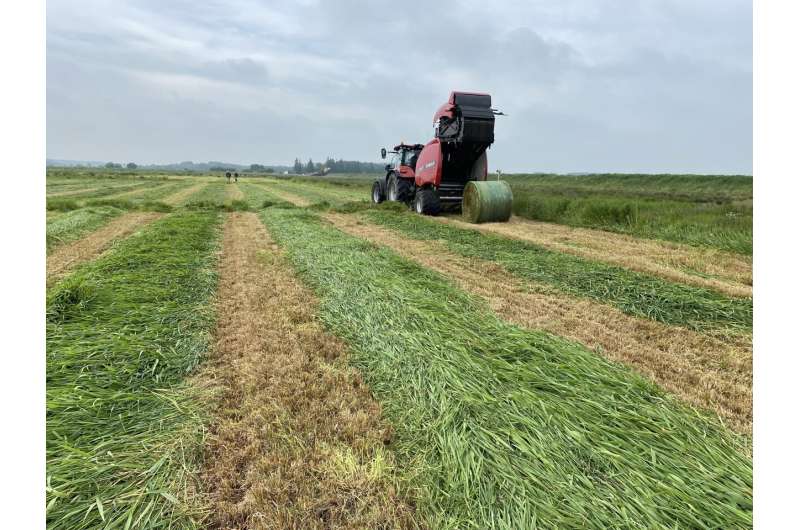This article has been reviewed according to Science X's editorial process and policies. Editors have highlighted the following attributes while ensuring the content's credibility:
fact-checked
peer-reviewed publication
trusted source
proofread
Stop drainage and cultivate reed grass instead of potatoes on peat soil, says agricultural emissions study

Drained peat soils in Denmark account for about one-third of agricultural greenhouse gas emissions.
"One of the most effective climate measures we have is to stop draining peat soils. However, this means that the land cannot be cultivated in the same way as regular agricultural soil because it would become rewetted," explains Poul Erik Lærke, a senior researcher at the Department of Agroecology at Aarhus University.
If farmers are unable to cultivate the land, it would be necessary to compensate landowners for the loss of value, which would incur significant costs for society.
"But part of the loss could actually be offset if the land is used to cultivate crops that thrive in wet conditions. At the same time, it can also reduce the risk of other natural areas being converted into agricultural land as compensation for the loss of current agricultural production on peat soil," he explains.
Three production scenarios
In a new study, Henrik Thers and other researchers from the Department of Agroecology used calculation methods typically used for life cycle assessments to investigate greenhouse gas emissions for three different cultivation scenarios.
"We used IPCC emission factors and cultivation conditions for peat soils in bogs and wet meadows," explains Thers. The study included three different scenarios, which are as follows:
-
Potato crop rotation on deep-drained raised bog peat soil
-
Perennial reed grass on undrained raised bog peat soil
-
Perennial reed grass on poorly drained wet meadow peat soil
The results show that greenhouse gas emissions can be significantly reduced by switching from the potato crop rotation to reed grass cultivation.
"We found that greenhouse gas emissions from the potato crop rotation in the raised bog, scenario 1, could be reduced by 35% by switching to cultivated reed grass on undrained raised bog, scenario 2," says Thers.
Furthermore, the analysis showed that greenhouse gas emissions from scenario 3, reed grass cultivated in the wet meadow, were even lower than the emissions from scenario 2. According to the researchers, this is primarily due to differences in the average annual water level.
Biomass for biogas and biorefining
If traditional potato production is replaced by reed grass production, it is also necessary to find new uses for the crops. Unlike potatoes, reed grass cannot be consumed by humans.
"On the other hand, production and harvesting of biomass on undrained peat soil can be used for various purposes in biorefineries, for biogas, or for pyrolysis, thus replacing other protein sources or the use of fossil resources. This potentially increases the calculated reduction in greenhouse gas emissions when switching to grass production on undrained peat soil," explains Thers.
"Our analysis does not include the use of the harvested biomass since such an analysis can only be performed on specific end products that include all by-products. As a simplified alternative, the reduction potential is therefore calculated based on the amount of produced biomass or raw protein, which shows an additional reduction when switching from the potato crop rotation to reed grass."
The study does not include production economics, and the researchers acknowledge that reed grass production will face challenges in competing economically with potato cultivation.
Local knowledge is crucial
According to the researchers, it is not always possible to fully saturate previously drained raised bogs even if the current drainage is discontinued, but significant reductions in greenhouse gas emissions can still be achieved.
"It is likely that the original vegetation dominated by sphagnum mosses needs to be restored to make the bog wet again during the summer months, and that can take time. We do not see the same challenge in wet meadows, where the water level is primarily controlled by the water level in the stream that the fields drain into," explains Lærke.
The researchers emphasize in their study that having knowledge of local conditions is essential when estimating the reduction potential for greenhouse gas emissions related to wetting of drained peat soils. Therefore, the land use after discontinuing the drains can still be a new form of biomass production if the agricultural land is not converted into wild nature.
Harvesting and removing biomass can also be an important tool in efforts to achieve nutrient-poor soil before the area is handed over to wild nature, thereby contributing to a more diverse vegetation.
Reed grass production can be used to restore original ecosystems
"The demonstration experiment with reed grass in Store Vildmose showed that it was possible to remove large amounts of nutrients from peat soil and net remove more nutrients with moderate fertilization compared to no fertilization. Therefore, reed grass production can also be a step towards the restoration of the original ecosystem with high biodiversity," says Lærke.
According to the researchers, their study highlights the need for further research and adaptation of methods to implement effective strategies for reducing greenhouse gas emissions from peat soils. There are still many challenges and complexities associated with wetting peatlands, but the results demonstrate the potential to reduce agricultural climate impact while maintaining some production on peat soils.
The paper is published in the journal Heliyon.
More information: Henrik Thers et al, Comparison of GHG emissions from annual crops in rotation on drained temperate agricultural peatland with production of reed canary grass in paludiculture using an LCA approach, Heliyon (2023). DOI: 10.1016/j.heliyon.2023.e17320
Journal information: Heliyon
Provided by Aarhus University

















